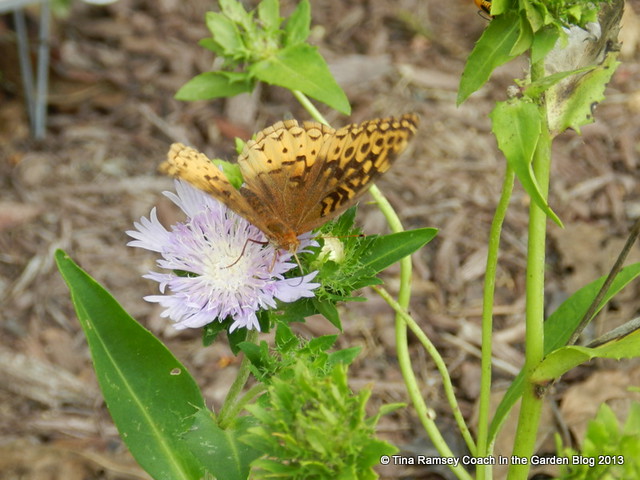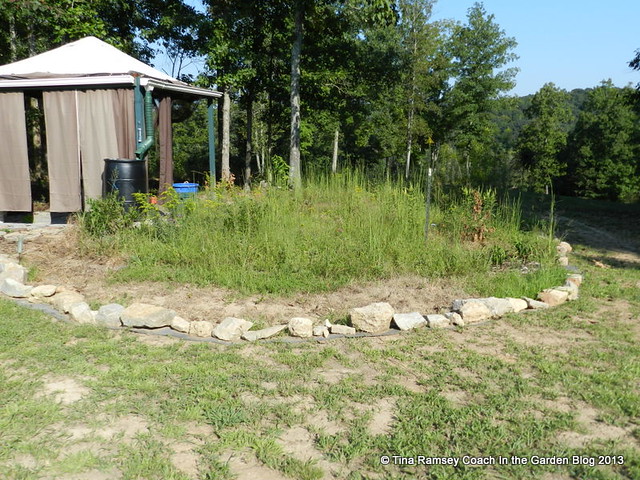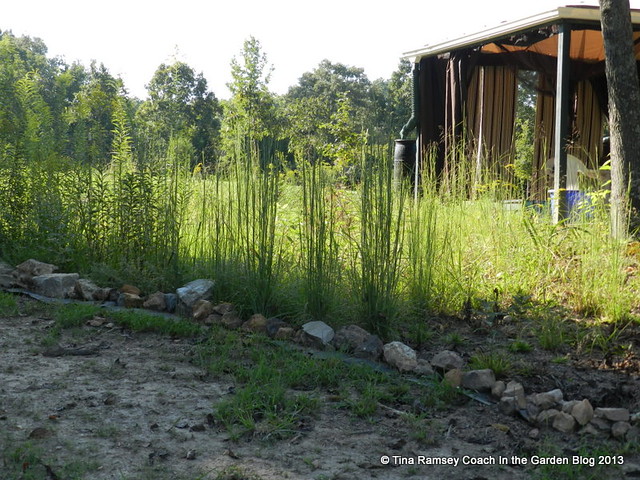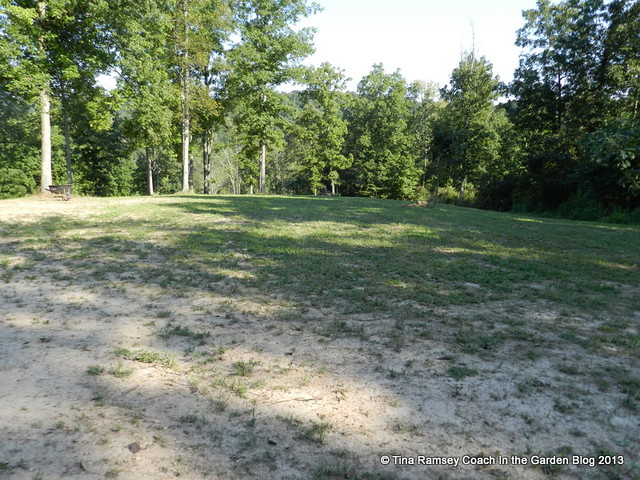
Time in a garden passes by in a blink of an eye! Just ask the little frittilary who found the newly planted stokesia on the farm a nice place to land and get some nectar.

For the gardener time is ticking right along too, and I for one cannot believe it is already September! Anyone else feel the same way? It seems like only yesterday I was starting summer working hard on moving my garden out to our farm and here it is nearly the fall and things have slowed down a bit. Fortunately, this summer has been the best ever as far as weather wise and plant growth and health. It is a good thing or I think I would not have been as successful in getting some gardens started out at the farm. So far many perennials have gone into the above garden, a fairly large viburnum collection has been moved and is doing well (though I have had to water often), five crepe myrtles are blooming their hearts out, all of the PG hydrangeas (12) I moved back in the spring are doing well in full sun though they have not bloomed, our orchard and berry patch have begun to take shape, the pond area is a work in progress, and overall things are slowly taking shape.
There have also been some losses and mistakes throughout the last few months. I moved about eight oakleaf hydrangeas out to the farm for placement along the driveway. All but a few have died and what ones are left wind up being deer food. It did not help that I planted them straight into the ground without thinking about drainage. Farmer Fix-it and I had to rectify that by building a rock garden and back filling with on site soil. A big process but hopefully the few oakleafs remaining will do fine and I can move more out there in a month or two. Oakleaf hydrangeas are notorious for not liking wet feet and as we have found out, our soil is a heavy clay that doe snot drain all that well. Raised beds have rectified the problem now. Sometimes it helps me when I write down all Farmer Fix-it and I have done I feel better, but then I remember all that is yet to come and I can get a bit overwhelmed. The good news is I can pace myself and really, if everything does not get moved and situated it will be okay. I will most likely open up my current garden for a plant sale-you dig! I can tell you stories about digging but today is about my new Prairie Garden. It is not really a prairie garden (that is the wildflower field in another spot on the property), but more of a drought tolerant garden with mostly native plants.
Late fall and winter is the absolutely best time to move trees and shrubs and I will be starting this process probably in November. Before I can begin moving shrubs and trees Farmer Fix-it and I must clean up all the trash our neighbors in Stewart County dumped on the property out by the road, and thin out some trees. This job alone will take a few weeks and involve delivery of a large dumpster, but we have a plan and slowly work it out. I just read in the newspaper that Stewart County has the second lowest recycling rate in Tennessee. I believe it. If you could see what folks trash and dump on the side of the road you would understand. It is really an awful thing I'm ashamed of when it comes to my chosen state to live. If the front area was cleaned up, I'd be moving trees like some of my many Japanese maples. In the meantime my trees and shrubs are getting bigger. Some, like my Limelight hydrangeas and serviceberry tree are huge. It will be a big job to move them all and I am dreading it. The payoff will be further down the road. More on them later.

Today I was kind of going to talk through my process of gardening on the farm. Keep in mind we have no water or electricity but we do have a small shelter in the form of the gazebo I built back in April. Near the gazebo was where I began my gardening process since I am sure it is located in an area that will not be disturbed by the home building process, although the electric lines may come by this area. I can however direct the installation away from the gardens since I allowed space for them in my plan. You would think that as a landscape designer I could plan more of the gardens logically and most of the time I do, but not in the case of these gardens around the gazebo. Back in March, in my haste to move daffodil bulbs to the farm (nearly 6500 so far!!) I planted 600 'Sun Disc' daffodil bulbs in the area that is now located under about two feet of top filled soil in the above garden. I seriously doubt I'll see many of those bulbs. On the other (right) side of the gazebo I planted 600 'Minnow' daffodil bulbs. Those ones will be okay because I did not have to back fill that side of the garden. I am not too terribly upset about losing the bulbs to the ground, but I am kind of mad I wasted my time planting here only to then fill in over them. That is where good planning comes in and while I've tried to eliminate all future problems since this one, I have not always been successful. When designing a garden I think you should plant once and that is it! Even though I think that way it is not always the reality for me.

Back to the left side (the side pictured in the two above pictures) I focused my attention on this part of the garden. The property slopes down here a bit and I wanted to level it out. I managed to make several trips to move all of these rocks from my current garden out to the farm and had the great idea to make a rock wall. It all somehow worked out nicely. Building the rock wall enabled us to backfill the area and to level the very large garden and also made a good spot for a new garden. This area is about 100 feet away from the back of our home to be. As such it needed to be an area that would show up nicely from a great distance. The rocks fit the bill. The next step was to backfill; which was done by Farmer Fix-it and his handy tractor. All soil was taken from where the house will be built and unceremoniously dumped into this garden area. Weeds and all. Once things were leveled up a bit I tried to smooth out the fill dirt, mulched with newspapers and cardboard, then spread three trailer loads of shredded hardwood mulch on top of the cardboard. All the while I was envisioning this new garden. My vision is to have prairie style plants tiered down toward the front. All plants had to be very drought tolerant, butterfly attractors, and hardy tough plants that won't need any fussing from me. This side of the garden has a color scheme of yellow, blue, pinks, and purples. There will be no red or orange in this side of the garden. Each perennial will have about a 6-7'+ circle area in which to grow into. The spacing was the hardest part for me. You know gardens look rather bare when spaced appropriately and my new garden is no exception. It is at the time of planting I make most of my mistakes by planting too closely. I therefore disciplined myself to show restraint and to measure the distances from each plant. If, for example, an amsonia gets three feet tall by 4-5' wide, I would plant it midway in the garden and half of its widest distance from its neighbor. That meant amsonias were planted 2.5' from the space of an adjoining amsonia; which actually totalled 5' by the time you add in the space for both amsonias. That's a long way apart for a new garden not to have any plants but in a few years the result will be a much better garden easier for me to maintain since I won't have to divide and move plants. Underestimating just how big plants will get and planting too closely is a common mistake for all gardeners.
The plants for this side of the garden from the wood line out include: 5 heucheras, 7-9 'Stella de Oro' daylilies, 5 'Sun Drop' primroses, 5 Amsonia hubrichtii, 5 native baptisias, 5 catmint, 9 'Autumn Joy' sedums, large clumps of: Compass plant, 'Maximillion' helianthus, asters, native beebalm, Joe Pye weed, Tartarian asters, obedient plant, Culvers root, rudbeckia, coneflowers, veronica, stokesia, cannas, salvia, low growing sedum, and lantana. All plants are tiered with the shortest to the front leading up to mid level plants and the tall overbearing plants like helianthus, compass plant, tartarian asters, and Joe Pye weed along the back outside of the wood line. As you can see from the pictures only the catmint, Stellas, and 'Autumn Joy' have filled in and are most visible. If you look closely you can see the other clumps of perennials in the background but they are still small and will take time to fill in. The amsonias I planted had to have a 5' circle diameter just for them and they were quite small so they are not even visible in these pictures. I explained this process above. It kind of looks like a lot of mulched area there but believe it or not there are perennials there and with time they will fill in nicely. I have done nothing to this garden as far as watering or pruning it but I do occasionally pull sassafras trees and other weeds out of it as they push through the mulch. All of the colors in this part of the garden are like I described above: yellows, pinks, blues, and purples. Standing back from this garden I am finally able to see the bones and getting it together. I can't wait for next year now!

Now the right side of the gazebo is a whole other story. This side is already quite level and is surrounded by rocks (moved from my current garden). To the right of this side is a drive spot to our back lawn we affectionately call our 'Back 40'. This is also where I anticipate the electric lines to come through-underground. I had an issue with this garden in that there are many wildflowers already growing in this area. I am trying to use what we already have on the land so I did not disturb this area. One bonus was the numerous clumps of native butterfly weed. I posted on it here. The butterfly weed was in a perfect spot in that it is centered in the garden. Since butterfly weed is a hot colored orange I have leaned toward the reds and oranges over in this half of the garden. The two sides of the gazebo should be quite the contrast with the left being yellows, blues, and purples and the right being reds, oranges, and yellows. I may throw in some other colors but for now this is the direction I am leaning.

While I have planted some things over here I have not prepared this garden at all. Can you see how the natural state is? It is all overgrown and full of wildflowers. Goldenrod joins the butterfly weed as well as other unknown things. I would love to start on this garden but have other priorities ahead of it. Toward the front of this garden I have sprayed Roundup to kill some of the existing vegetation. I plan to do this with the whole garden less the butterfly weed and other plants I have already planted here. Once the vegetation is killed off I will mulch it in the same manner as I did the left side of the garden area. Then I will begin planting in earnest-hopefully. It may be too late in the season to move many perennials so it might not get planted until next spring. In the meantime there are 600 minature 'Minnow' daffodils plus some 60 Lycoris radiata planted here that I can enjoy.
You might notice the two rain barrels next to the gazebo area. I had a total of 5 rain barrels here at the house and decided to move two unused ones out to the farm to help out with watering. Farmer Fix-it and I had the idea to run gutters around the 10' x 12' gazebo area. It is really not a gazebo but mainly a wooden frame with a gazebo top on it. Since the cover is fabric not much water runs off from it to the gutters but we do manage to catch some water from it and from the falling rain. Enough in fact to fill up both rain barrels after a couple inches of rain. Even with these full rain barrels I have not had to use much water from them in order to water these gardens. I normally use the water to water the large trees we have planted. The trees are what soaks up all the moisture and need a lot of watering. Especially a new special oak tree. Each time I plant a tree I feel like I am planting for the future and someday my grandchildren will enjoy the shade from those oaks. That is why I focus most of my attention on trees. Most perennials will take care of themselves once they have received at least one rainfall after planting. At least it seems that way to me this summer but then again I did plant drought tolerant perennials and we have had AWESOME rains this summer.

If you look at the left side of the garden from behind it (from the direction of the Back 40) you see a completely different view. This picture shows that in addition to the wildflowers we have some native grasses in the form of Little Blue Stem. I knew we had some blue stem but did not realize just how much. As such the fact it is growing here has changed my whole way of thinking. I am trying to figure out how to preserve it and leave it in place. This particular garden in the wood line and on the back side will be left all natural and the little blue stem will be a big part of the design component. Initially I honestly thought to leave all the area around gazebo native and natural but I just don't like the messy messy look of it all and have found that with cultivated plants I can actually enjoy the butterflies and wildlife even more. As I start on this area of the garden I will move the little blue stem to other areas on the property. It is widely adapted for our land and should transplant well.

The above picture is the Back 40. While I'd love to leave this area all natural the fact that the chiggers are unbearable and the fact that we'd like to enjoy our land I have decided to mow it and turn it into a back lawn area. If you look in the distance the land slopes down. This hill is actually several hundred feet long. Once you go over the crest of the hill, the area is all natural and I have left the little blue stem and dropseed alone to colonize down there. I am hoping with proper management we can get it back to its natural state with minimal care. Allowing the natives to take over here helps me out with no mowing and hopefully less erosion on the hill, but on the top part of the hill there must absolutely be fescue grass so as to enable us to enjoy the area.

Many people said the deer will devour my new garden but so far I've had pretty good luck. This luck was not only due to Lady Luck but I also chose perennials and shrubs well. Fragrant perennials and native perennials are what I reasoned would be safe from the deer. I was correct to a point. The only things the deer have nibbled are: Joe Pye weed, a plum tree (not the pears), and some of the hydrangeas-oakleafs. I find it weird they did not eat more but consider myself lucky. The lantana, catmint, butterfly weed, asters, bee balm, amsonia, blueberries, and numerous other things have not been bothered-thus far. Perhaps by this winter when food becomes more scarce we may have more nibbling.We also have rabbits as evidenced by the nibbling on the newly planted corn Farmer Fix-it and planted back in July. That nibbling did not kill the corn and only set it back a bit. We put out repellents and it seemed to help. Even so, our corn has not done well at all. I did eat one ear right off from the stalk while on the land. Baby corn that is fresh picked is good uncooked--and no worms! And good for you!
Well, this is a long post. I am not known for not being wordy. HA! I like keeping track of the land and what we have done and the blog is a great reference tool for me. As we are learning all sorts of new things on the land I find I am on the computer more and more to learn of others' experiences. Oftentimes it is hard to find good references so I do tend to be wordy with my experiences so that not only can I look back at them, but perhaps my posts can help others....
in the garden....
And speaking of experiences, many thanks to Gaia Gardener for sharing her experiences with restoring her native area back to its natural state. She sent me several emails detailing her processes. I am a researcher and love to learn and experiences are usually the best school!
You are a pioneer Tina. This wears me out just reading it. I am so fascinated by this process. I am glad you are sharing it all with us. It makes one realize a great garden is a lot of work and not chance.
ReplyDeleteLisa--I am sure it did wear you out as it is LONG. Did not realize how long!
DeleteHow neat to see what you have done there at the farm. It must feel so peaceful out there, and your minds must be full of so many plans and ideas and they and your hard work are coming to life.
ReplyDeleteGREAT JOB!
FlowerLady
Thanks Flowerlady! It is a labor of love for sure.
DeleteLooks great Tina.
ReplyDeleteThanks Lola!
DeleteEverything is looking so good Tina! You need to get those deer in line before winter for sure. You have had a great year to get things in place and I hope Mother Nature continues to work with you! I also hope the Dept of Electricity does not run into much rock below the ground or they may be going right through your gardens! Yikes, that would set you back a bit but you have plenty of time to work it all out.
ReplyDeleteYesterday we were out at the lake Geo-Caching on some islands and near some fishing spots. It appalled us to see the trash some have left behind. I mean come on people, if you take it out, take it in. Grrrr....
Your property looks like a park, Tina. I'm sure that your grandkids will enjoy the fruits of your labor for years to come.
ReplyDeleteI was wondering about something. You said at one point in your posts about the property that you have underground springs which could indicate a cave system. Have you found any evidence of that?
I can't get over how much you have done in a short time...summer whizzed by with no work in the garden for me...unfortunately I only have about 6 weeks left here before I cannot do any more work...lucky you with an extended garden season.
ReplyDelete